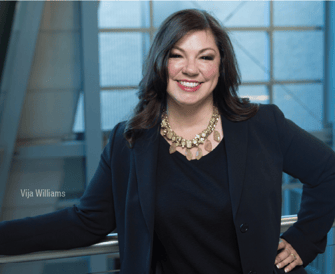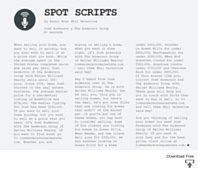Scripts That Work
Keller Williams associates Josh Anderson and Vija Williams take to the airwaves for lead generation.
On different sides of the country, two Keller Williams associates are finding solid leads by harnessing the power of local market radio.
Josh Anderson, who works in the Nashville – Green Hills (Tenn.) market center, leverages the advertising route, buying ad spots on two local stations. In the Pacific Northwest, Vija Williams, of the Kirkland (Wash.) market center, hosts a weekly radio show targeted to potential clients and fellow real estate agents.Coincidentally, both agents began using radio for lead generation because of personal relationships within the industry. Williams worked in radio advertising prior to real estate and has family ties to the industry.

“My father-in-law is in the Radio Hall of Fame and continues to own and operate radio stations, and my father had a radio advertising background, so I came into radio with an immense amount of knowledge before even stepping in front of a microphone,” Williams says.
Anderson, on the other hand, has a real estate client who happens to be one of the most popular talk radio hosts in Nashville.
“Phil Valentine is the host of the show we run our spots on, and he happens to be a personal client of ours,” Anderson says. “He probably gives us a lot more advertising than we actually pay for because he’s worked with us and knows who we are outside of advertising.”
Phil Valentine’s show casts a wide net, ranking as the No. 1 afternoon talk radio show in middle Tennessee. The program is syndicated in 60 cities and attracts a loyal listenership, which is why Anderson opts for Valentine himself to read the ad spots.
“People who listen to Phil Valentine have been listening for 10-plus years,” Anderson says. “If I brag about our team, it’s not the same as him saying, ‘Josh is my agent. He sold my house.’ People have been trusting him for years, and they don’t know me from Adam. Besides, he’s got the better radio voice. And if anything comes up about people moving to Nashville or the housing market, he brings my name up even if it’s not an ad. I go to lunch with him every six weeks, so I’m staying in his mind and telling him things about the market.”

In 2014, The Anderson Group produced $60 million and by the end of November, was already at $73 million year-to-date for 2015. Of the 220 deals they will do this year, Anderson anticipates that 12 percent will come from radio. The results from three years of advertising on Phil Valentine’s show has led Anderson to pursue ad buys on a second station, starting six months ago.
“It’s a Christian radio station, and it’s a much smaller frequency,” Anderson explains. “When we started on talk radio, I did my own research and looked at the demographics of who listens to talk radio, what their income brackets are, their education, because all that plays into who the potential client is. I did the same thing with the Christian radio station. Both stations have extremely loyal followers, and there is very little crossover between the two. Also, I don’t get any competition when I’m on those radio stations. When I get a lead off the radio, I don’t go to a listing appointment and compete with anyone else just because of where that lead is coming from and how much they trust the hosts of both of those stations.”

The format Anderson sticks to for his ads is that they run two weeks on and two weeks off. During the on times, the main piece is one 60-second ad per day, live during the broadcast. In between, shorter 15- to 20-second spots run sometime through the day. You can
download Anderson's radio script for free.
“We constantly change them up, at least every month, but we like to do it every two weeks,” he says. “If you hear the same ad over and over, you tune it out. So, in our ads, we use topics like market statistics as well as our team statistics, like that the average agent sells five homes a year and we’ve sold 219 this year so far, or that we get 99.1 percent of the asking price. We will talk about supply and demand and changes in inventory. We’re 100 percent targeting listings, because if we get listings, then we get a buyer out of those listings.”
Because of the constant turnover in ad content, Anderson and his team frequently use the ad spot to launch different strategies like targeting specific locations or for more creative calls to action.
“Our new thing we’re trying out is being ZIP code-specific,” he says. “Instead of saying city names, you know we’re talking to you specifically. We’ve also done ads geared toward ‘If you buy one of ours, we’ll sell yours for free.’ Nobody takes us up on that, but it gets them to pick up the phone. We’re constantly letting them hear something different, and we’ll even use the spot to look for hires because it hits so many people. We’ll say we’re looking for salespeople who want to make six figures a year. We’ll throw one of those ads in every fourth or fifth time. If we get one person out of it who wants to become part of our organization, that’s a pretty good use of our time and money.”
Currently, Anderson budgets about $4,000 a month for radio advertising.
“We’re getting $3 to $4 back per dollar we spend in radio advertising,” Anderson says. “If we spend $45,000 to $50,000 a year, we’re probably getting $150,000 to $200,000 in gross commission income. A big piece of our business is built on lead generation, and I think the radio ads really allow us to focus on that and have people calling us rather than us calling them. It’s a two-pronged approach because it also offers long-term branding and marketing.”
On the opposite side of the country, Williams hosts a 30-minute weekly radio show called “Real Estate Radio.” She leverages the show by also making it available via YouTube and on her Website.
“To me, leveraging the content is the most important aspect unless you are on a radio station that has a powerful signal and a large listenership,” Williams says. “Most affordable talk radio options are on the small radio stations that do not. Therefore, the primary reason to do radio in the format that I do it in is to have Internet content to use with your digital footprint online. In addition to YouTube, we use our radio shows on our database 33 Touch program. We put it on all of our email signatures and our CRM drip campaigns. We put it on our print advertising. It is used a lot in our social media marketing.”
In 2014, The Vija Team sold $37.5 million in volume with 59 units for $845,000 in GCI. Year-to-date as of October 2015, those numbers have climbed to $42 million in sold/pending volume, 80 units and $1.2 million in GCI. Williams is quick to credit radio for those numbers.
“Radio has played an integral role for us in lead conversion, credibility, recruiting and lead generation,” she says.
When Williams joined Keller Williams Realty in November 2010, she also became a member of KW Luxury Homes International that same day. Today, approximately 25 percent of her sales are luxury homes, and she believes radio has helped her attract that market.
“Radio is one of the best ways to target a specific niche or demographic, and we definitely use it for high-end and luxury,” she says. “We technically target move-up and move-down buyers and sellers in the $500,000 to $1,500,000 price range, so in our market, that’s what I call high-end and entry-level luxury. I choose topics specifically targeted to that demographic and target geographic areas that are relevant to that target market.”
Williams selects guests to appeal to luxury clients and other real estate agents.
“Guests are selected based on the topics we want to address and whether we think they will sound good on the radio,” she says. “The topics we address are based on our target markets in the greater Seattle area and the real estate agent community who gives us a lot of referral business around the country.”
This article originally appeared in OutFront magazine.

 “My father-in-law is in the Radio Hall of Fame and continues to own and operate radio stations, and my father had a radio advertising background, so I came into radio with an immense amount of knowledge before even stepping in front of a microphone,” Williams says.
“My father-in-law is in the Radio Hall of Fame and continues to own and operate radio stations, and my father had a radio advertising background, so I came into radio with an immense amount of knowledge before even stepping in front of a microphone,” Williams says. In 2014, The Anderson Group produced $60 million and by the end of November, was already at $73 million year-to-date for 2015. Of the 220 deals they will do this year, Anderson anticipates that 12 percent will come from radio. The results from three years of advertising on Phil Valentine’s show has led Anderson to pursue ad buys on a second station, starting six months ago.
In 2014, The Anderson Group produced $60 million and by the end of November, was already at $73 million year-to-date for 2015. Of the 220 deals they will do this year, Anderson anticipates that 12 percent will come from radio. The results from three years of advertising on Phil Valentine’s show has led Anderson to pursue ad buys on a second station, starting six months ago.
